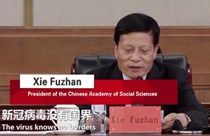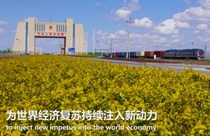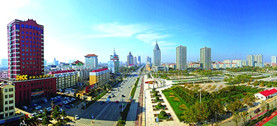
. > TOP STORIES
Projects to bridge east-west gap in computing resources
Author : DUAN DANJIE Source : Chinese Social Sciences Today 2022-07-15
In February 2022, the National Development and Reform Commission and three other central departments approved projects to build eight national computing hubs and plans for 10 national data center clusters. The move indicates the completion of the overall layout for the national integrated big-data center system and that a strategy is in full swing to channel more computing resources from the eastern areas to the less developed western regions.
This is another important national strategic endeavor in China following the south-to-north water diversion project, the west-to-east power transmission program, and the west-to-east gas transmission project.
East-west comparative advantages
By building a new computing network system integrating data centers, cloud computing, and big data, the projects allow data to flow from the east to the west for storage and computing purposes.
At present, most of China’s data centers are located in eastern regions. However, due to a shortage of land resources and high electric power costs, a machine with 100 petabytes of computing power consumes about 50 million yuan of electricity annually, which poses a challenge to achieving carbon neutrality and carbon peaking. By comparison, China’s western regions have richer land and clean energy resources, providing favorable conditions for the construction of computing storage, explained Zheng Weimin, an academician of the Chinese Academy of Engineering and a professor from the Department of Computer Science and Technology at Tsinghua University.
By the end of 2021, up to 5.2 million data center racks were in use in China, with an average annual compound growth rate of more than 30% in the past five years. Data centers not only occupy land, but also consume a lot of power to process data, according to Chen Ying, deputy director of the Research Center for Sustainable Development at the Chinese Academy of Social Sciences.
Data show that China consumed a total electricity amount of around 8.3128 trillion kilowatt hours in 2021. The annual electricity consumption of data centers accounted for about 2% of this total, and it is growing rapidly. Chen said that for most cities and regions, without special electricity discounts or subsidies, electricity costs would account for about 60% of operating costs, and it can be as high as 70% to 80% in places like Beijing or Shanghai. Data centers are not only large power consumers, but also large carbon emitters. In 2021, the carbon emissions of national data centers reached 78.3 million tons.
Among the places where the eight national computing hubs will be built, the Beijing-Tianjin-Hebei region, the Yangtze River Delta, the Guangdong-Hong Kong-Macao Greater Bay Area, and the Chengdu-Chongqing economic circle are at the core of China’s economic development, with a large user scale. The Inner Mongolia Autonomous Region, Guizhou Province, Gansu Province, and Ningxia Hui Autonomous Region are among the western regions, and their local computing power demand is not large. As such, they can take over data computing demands from the eastern regions.
According to the national layout of an integrated system of big data centers, the eight national computing hubs, as the backbone connections to China’s computing network, will develop data-center clusters, carry out collaborative construction between data centers and networks, cloud computing, and big data, and bridge the gap between eastern and western regions in computing resources.
Zheng said that the computing power hubs and data centers in the west can mainly be used to handle background processing, offline analysis, storage backup, and other services that do not have very high network requirements. Those in the east are mainly used to process the industrial internet, financial securities, video calls, games, reasoning in artificial intelligence, and other services that have higher network requirements.
Great potential
As of April 2022, among the 10 national data center clusters across the country, 25 new projects have been started, with a data center scale of 540,000 standard racks and enormous computing power, driving investment of more than 190 billion yuan in many respects.
The starting areas of the Zhangjiakou data center cluster, which are under construction, consist of Huailai County, Zhangbei County, and Xuanhua District of Zhangjiakou City, north China’s Hebei Province. The data center cluster will actively undertake the real-time computing power needs of Beijing and other places and build itself into a real-time computing power center that radiates to north China, northeast China, and even the whole country. Up to today, 12 data centers including those of Alibaba, Tencent, and Qinhuai Data have been put into operation here, with 1.03 million servers.
According to Lin Xinhua, deputy director of the Network & Information Center at Shanghai Jiao Tong University, compared with the south-to-north water diversion project, the west-to-east power transmission program, and the west-to-east gas transmission project, these projects concerning computing resources have an essential difference. To be more specific, they involve data, which is a man-made resource, while the former three projects all involve natural resources. The threshold for the use of natural resources is low, and staffing requirements are also low. However, data has a higher threshold as a human resource. The value of data can only be maximized in the hands of people with professional knowledge and skills. As such, the smooth development of these projects requires support from a large number of data and computing professionals.
“We should pay special attention to this issue, intensify talent training, enlarge the talent pool, and upgrade the service level,” Lin concluded.
Ye Shengtao made Chinese fairy tales from a wilderness
Ye Shengtao (1894–1988) created the first collection of fairy tales in the history of Chinese children’s literature...
-
How northern ethnicities integrated into Chinese nation
2023-09-18
-
Mogao caves
2023-09-12
-
Mogao Grottoes as ‘a place of pilgrimage’
2023-09-12
-
Time-honored architectural traditions in China
2023-08-29
-
Disentangling the civilizational evolution of China
2023-08-28
-
AI ethics in science fiction
2023-08-23













 2011-2013 by www.cssn.cn. All Rights Reserved
2011-2013 by www.cssn.cn. All Rights Reserved